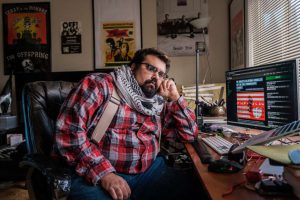JANUARY 10, 2021

Abner Hague who runs Left Coast Right Watch, a website that monitors hate group activity, works from home. – Nick Otto/TWP
Before a mob of Trump supporters staged a riot in the U.S. Capitol and thousands of Americans became amateur detectives working to identify the culprits, a loosely connected group of seasoned online sleuths were ringing alarm bells and picking off extremists online, one by one.
For a nationwide network of left-wing activists who seek out and publish the identities of those they believe to be violent “fascists,” some investigations can take months, years even.
Or it can take 10 minutes.
That’s how much time Molly Conger spent on her laptop last month searching for the man who used the right-wing social media site Parler to share that he was a police officer and pledge support to a member of the Proud Boys extremist group, advocating violence against Supreme Court Chief Justice John G. Roberts Jr..
Turns out the man was a Prince William County sheriff’s deputy. Fifteen-year law enforcement veteran Aaron Hoffman acknowledged he was behind the profile picture of a sheep holding a machine gun, though he maintained in an interview with The Washington Post that his account had been hacked. Alerted to Hoffman’s online presence by Conger’s tweets, the Northern Virginia county’s sheriff fired Hoffman the next day.
Conger, 30, a freelance journalist in Charlottesville who live-tweets local government meetings and posts pictures of her miniature Daschunds under the handle @socialistdogmom, has made doxing “Nazis” her day job — and she is part of a small coterie of left-wing activists who monitored far-right violence long before it arrived at the forefront of the American conscience. They follow online clues to learn the hidden identity of perpetrators. Some go so far as to infiltrate the messaging groups of their targets by impersonating new members.
The majority of people who do this work are anonymous, like their targets, though a handful have been outed and continue to dox others. They often describe themselves as antifascists and are eager to present a faction of the movement that works behind the scenes to prevent violence. They’re tech-savvy, meticulous and incensed by the rise of the far right. They reject the idea that antifa’s methods are steeped in violence — a narrative advanced by President Trump and his supporters.
Conger lives off donations from a growing audience of social media users who want to see consequences for anonymous members of far-right groups who plot violence online and carry it out at demonstrations across the country.
“I’ve just always been very nosy,” said Conger, a former project manager at an education software company. “If you’ve ever stayed up way too late trying to find your ex’s wedding pictures on Instagram, you can dox a Nazi. It’s the same skill set.”
For many, the “Unite the Right” rally in Charlottesville in 2017, where Heather Heyer was killed by a white nationalist demonstrator, was a tipping point.
“I was not super politically active prior to that,” Conger said. “I was very invested in my job and had my head down and things just got progressively worse until someone got murdered by a Nazi in my neighborhood. This is not a couple of guys on 4chan. These are people who were willing to come together in real life and do real violence. That sort of changes your perspective.
“So now my life is about making it a little bit harder to be a Nazi online.”
Humiliation and accountability
If Hoffman’s goal was to keep his Parler identity anonymous, his biggest mistake was easily avoidable. Last year he commissioned an artist using the freelance services website Fiverr to draw the armed sheep, and upon completion, Hoffman was nice enough to leave the artist a positive review on the site.
Conger, who had been forwarded the account’s comments by fellow activists monitoring a Proud Boy’s activity on Parler, used a reverse image search to find other instances of the drawing online, leading to the Fiverr page. Hoffman posted his review under the stage name Grant Tucker.
Conger then matched the photo on the reviewer’s account to a Facebook profile for a local country music musician, Grant Tucker. In one of the photos shared on the page, the man going by Tucker is pictured in his Prince William sheriff’s uniform with his name tag visible: “Hoffman.”
Conger shared the revelation on Twitter with more than 95,000 followers. Hoffman was fired hours later.
“That tells me they already knew,” Conger said of the timing. “They already knew, and because it was publicly embarrassing they had to do something about it. And if they already knew, how many more are there?”
Maj. Terry Fearnley of the Prince William County sheriff’s office told The Post the department was not aware of Hoffman’s social media activity until Conger’s posts.
“That type of behavior is not tolerated at the Prince William County sheriff’s department,” Fearnley said. “Never has been, never will be. And we want to stress to the community, if you see anything that looks like conduct unbecoming of our officers, please let us know.”
Conger says she shares less than 10 percent of the identities of the far-right agitators she identifies online. Some aren’t prominent enough in the movement for her to “dilute the discourse” by sharing their names, Conger said. Hoffman, she said, was a “white whale,” though, as a law enforcement officer.
The goal is not to bring physical harm or harassment upon the doxed, she says; she doesn’t post addresses, phone numbers or names of loved ones. The goal is humiliation and the accountability that comes with it.
“I’m interested in disincentivizing this behavior,” Conger said. “I’m interested in raising the cost of being a white nationalist, raising the cost of being a Nazi, raising the cost of making these threats anonymously online, and making it clear that these people are not as hard to find as they think they are.”
Conger, who began researching the far right in 2017, is a relative newcomer to the doxing scene. Most point to Daryle Lamont Jenkins, the founder of One People’s Project, as the father of the practice. In the early 2000s, Jenkins retaliated against fundamentalist Christian groups who were doxing abortion providers by doxing them back.

Lamont Jenkins argues in 2017 with Trump supporters in New Brunswick, N.J., as he and others protest the president’s executive order to halt some immigrants from entering the United States. – Mel Evans/AP Daryle
The 52-year old Jenkins has been an online mentor to many, including Richmond resident Kristopher Goad, whose interest in the far right began in 2013 when the Virginia Flaggers, a pro-Confederate flag group, began regularly demonstrating on a street corner blocks from his home. Goad, a lanky, mulleted restaurant cook who goes by @GoadGatsby online, responded by drowning out their protests with rap music pumped through stereo speakers, “because I figured rap music would upset them,” Goad said.
Goad was one of several counterdemonstrators assaulted by prominent white supremacist Christopher Cantwell at Unite the Right (Cantwell was later convicted of pepper-spraying Goad and fellow activist Emily Gorcenski).
“After that, I met Emily and we began putting our heads together trying to figure out who all these knuckleheads were,” Goad said.
That effort to identify violent Unite the Right attendees turned into a vocation for both Goad and Gorcenski. Goad has gone so far as to impersonate a hate group applicant to gain access to private social media chats in numerous far-right groups, which he monitors for plans to do violence. He says the desired outcome of a good dox is a “self-deplatforming,” in which a hate group member deletes his accounts and disappears from the far-right networks.
“This narrative exists that we just want to ruin lives,” Goad said, referring to criticism in conservative circles. “In reality, we want to protect lives from what seem to be like the most dangerous people that are given great authority in our country. We want to challenge that, and we want other people to know about it so they also challenge them.”
When Cantwell was facing criminal and civil charges for his actions in Charlottesville, part of his legal strategy was to shift blame to other masked men in his group, using their anonymous online handles as identifiers in court documents. Goad and Gorcenski saw it as a challenge.
“We wanted to be able to say, ‘Everything you’ve put in this lawsuit is now incriminating this other person,’ ” Gorcenski said.
She dug into cached webpages and online social media remnants until she identified each person Cantwell cited anonymously in 2017, then presented that evidence to police. Sitting across from Gorcenski in a police station conference room, University of Virginia police Sgt. Casey Acord was astonished, Gorcenski said.
“Do you want a job?” Acord asked, according to Gorcenski.
Acord did not respond to an email requesting comment.
Instead, Gorcenski spent the next three years doxing on her own.
“The story of what happened in Charlottesville has not fully been told,” Gorcenski said. “Part of our ongoing community defense is to leave a persistent reminder that there’s no way to do violence and get away with it.”
Looking into the abyss

Hague of the Left Coast Right Watch bought a gun when he started receiving threats online. – Nick Otto/TWP
Abner Hauge, who runs Left Coast Right Watch, a website that monitors hate group activity and identifies far-right demonstrators, purchased a gun after receiving threats. But it’s not the threats that wear you down, Hauge says. It’s the research, listening to hours of YouTube videos and podcasts of men making sexist, homophobic, racist and anti-Semitic remarks.
“Everybody has to take vacations from this,” said Hauge, 31. “We do this for as long as we can take it, and then the trauma makes us cease to function in a healthy way and we stop for a week or two and then jump back into it.”
Often, jumping back in means seeing the targets up close and in person.
On Wednesday, Conger made the 115-mile drive from Charlottesville to Washington to document what she suspected would be a day of right-wing violence inspired by President Trump’s address at the Ellipse.
She wore a longhair wig as part of a disguise (Conger normally sports a buzz-cut) to avoid detection — after her last appearance at a far-right gathering in Washington, she says, a member of the Proud Boys “put a hit” on her.
She spent the day on the Capitol grounds filming, zeroing in on exposed faces. Her lens captured the last breaths of one of the three Trump supporters who suffered medical emergencies during the short-lived insurrection and died. She drove home and submitted what must be a rare Google query: “how to get tear gas out of a wig.”
The nation’s collective shock at Wednesday’s events annoyed her. She saw it coming. Why didn’t everyone else?
“These people wanted blood, and we should be at least as clear about that when we talk about what they did — as they were when they talked about what they planned to do,” Conger said. “There should be no rationalizing or excusing this, no weaseling around with language about politically frustrated blue-collar Trump supporters caught up in the moment and expressing their beliefs or whatever nonsense people are bandying about.”
That authorities in Washington appeared to be as unprepared in the face of violent right-wing extremists as police in Charlottesville were in 2017 comes as no shock to Michael German, a retired FBI agent and fellow for the Brennan Center for Justice’s liberty and national security program.
German, who investigated domestic terrorist groups in the 1990s, says he’s seen a shift in how police handle right-wing violence.
“When I worked these cases, law enforcement knew that when a white supremacist group was discussing having a public event, that their purpose was to instigate violence,” German said. “So they made it more difficult for them to accomplish that objective of injuring people. We’ll make it so that you can come out and say your piece, but you’re not going to get within 100 yards of someone you can hurt, rather than the way we’ve seen over the past several years where we seem to be friendly to the far-right groups and aggressively violent towards the anti-racist protesters.”
Police have more “intrusive” information tools including databases not available to the public, German says, and the opportunity to arrest hate group members with outstanding warrants for unrelated charges, yet rarely take advantage.
“They could do far more,” German said. “How much of it is a lack of understanding of this intelligence and how much is a lack of interest in actually doing it?”
Activists who spoke to The Post lean toward the latter.
Christian Exoo, a 39-year-old library building supervisor at a college in Upstate New York, says he grew up with a childhood reverence for police officers until his late mother, Diane Exoo, a child advocate attorney and law professor, let him in on her work advocating for abused children and women.
“Cops constantly victimize marginalized communities,” Exoo said. “That disgusted me as a young person, that these guys don’t protect people from violence and, in fact, they do quite a bit of violence to people.”
In 2019, Exoo was responsible for the doxing of East Hampton, Conn., police officer Kevin Wilcox, then a dues paying member of the Proud Boys. Exoo stumbled upon Wilcox after realizing various chapters of the Proud Boys were paying their group dues openly on Venmo.
Exoo teaches a weekly seminar on doxing via video conference, sharing his methods with a vetted group of activists. In December, he identified three members of the Georgia Three Percent Security Force, an extremist militia group, who Exoo believes attacked unarmed protesters in Atlanta. One of the men was using the same profile picture he used on Zello as on Facebook under the alias “Drake Remora,” a reference to the sitcom “Friends.” Digging into the profile, Exoo found the man had shared his phone number on Facebook years ago while arranging for his house to be power washed. Caller ID data led to his actual identity.
After Exoo released the identity of the three attackers, he learned that at least two were fired from their jobs.
“These people need consequences,” Exoo said. “The consistent ideology across the far right is that human hierarchy is natural and desirable, that some people should have power over other people. And they all think violence is a path to power for them.”
Exoo has no qualms about discussing past doxes and tactics because he’s already been outed by hate groups and conservative journalists. It was inevitable: Exoo has joined hate groups in person and via video chat, performing well enough in interviews to gain access to private chats on websites like Zello and Gab. He wears his hair in a style that some in hate groups call “fashy” — tight-cropped sides with a side-sweep on top.
He faces daily death threats from people who describe murdering his family, too. He isn’t alone. One of Conger’s opponents hosted a podcast featuring a regular segment during which the hosts imagined new ways to rape her. Last year, Gorcenski moved from Charlottesville to Germany to continue her work with an ocean between her and people who threaten her life online. She has plans to soon retire from doxing.
“I want to go back to life,” Gorcenski said. “Before I was doing this, I was always against Nazis, but I didn’t spend 60 hours of the week opposing Nazis.”
Conger has trouble imagining doing anything else.
“It’s damaged my brain for sure,” Conger said. “We all have our own ways of getting through it. But ultimately, you’re not okay. Looking deep into the abyss at the worst parts of humanity on a regular basis is not good for you. But I need to know. I need to understand why these people are like this.”
Courtesy/Source: Washington Post










































































































